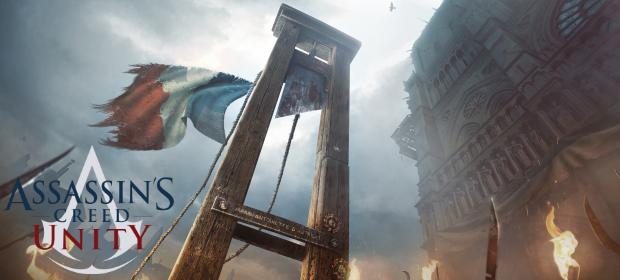Nearly one year on from when the new generation of games consoles entered our lives, we are now just over a month away from the first fully next-gen entry into the Assassins Creed series. Last year’s entry, Black Flag, was just one of the many titles to launch in the last twelve months to straddle the console gap, aiming to please early adopters and the slow to adopt all at once. With that in mind, I headed to Paris to go hands-on with Assassins Creed Unity for over three hours, and this is what I saw.
Assassins Creed has been through many changes in the last few years. The switch from traditional European setting to The New World in Assassins Creed III brought with it a host of new gameplay mechanics, and since then the series has not looked back, adding more and more to the AC recipe until we get to where we are today. That is until we get to Unity, a game that looks to take Assassins Creed back to its roots. Gone are so many of the modern day Creed staples, and instead, Unity is a tighter, leaner affair.
Unity’s story follows the young Assassin Arno Dorian, a man on the hunt for the people suspected of bellowing the fires of the French Revolution. Revolutionary France is a dark, dangerous place. Over populated cities, with political frictions rife, battles between the old world and the new, democracy and monarchy, the established elite and the educated pretenders. I got to see Arno graduate to become a fully fledged assassin, having previously been trained by another templar. Arno has quickly moved through the templar ranks, and his story of early bereavement and subsequent adoption by a templar calls to mind the stories of Altaïr and Ezio Auditore. This is not surprising given that the team behind AC 1, 2, and Brotherhood have been working on Unity for the past four years.
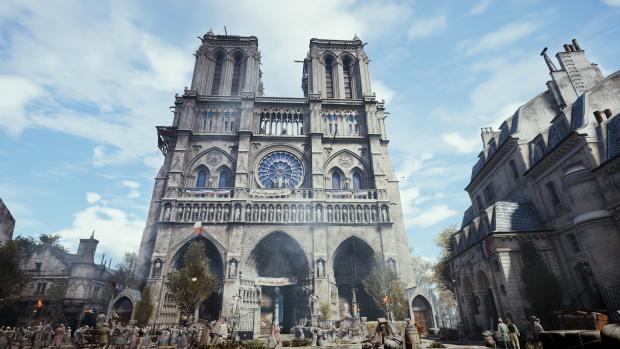
There is just the one city to explore in Unity: Paris. And there are no fancy ways of getting about, so don’t expect to see any horses or boats here. Gone are the hunting and crafting mechanics so important to previous games. Your inventory comes solely from the things you find and the money you earn, to spend in the shops and markets of Paris. You can suit your assassin up to look fearsome, choose weaponry and unlock new skills, becoming the targeted assassin that suits your style.
There may only be one city to explore in Unity, but what a city it is. Ubisoft’s vision of Paris during the French Revolution is a heart-stoppingly beautiful visualisation that is only possible thanks to the power of the hardware. Hundreds of characters, each of them brought to life in fantastic detail, appear on screen at once bringing life to the lovingly recreated Parisian streets, squares, and buildings. The spectacle on offer here is outstanding. Climbing Notre Dame to get to one of the first synchronisation points; the level of detail on show is incredible. Every window, spire and gargoyle making the experience instantly more meaningful and engaging. Arno Dorian represents one of the finest character models seen in gaming – really, it looks that good. Yes, I am gushing, but there are some drawbacks. The frame rate of the build I played did seem a bit on the low side. In fact, I would be surprised if it averaged the bare minimum 24 FPS at times. It’s not a deal-breaker (especially at this stage), but it is slightly jarring to see the frame-rate drop just when things are about to get interesting on screen.
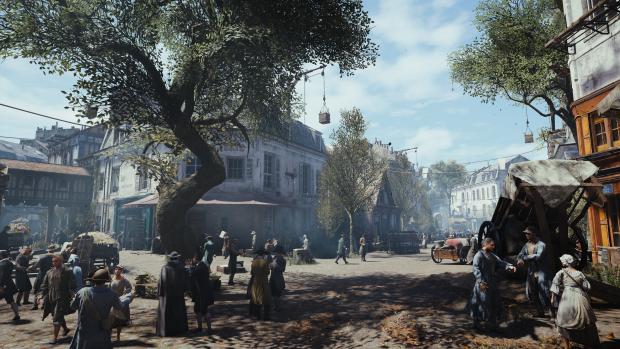
Given that Assassins Creed Unity shares much of its heritage with older entries in the series; it is no surprise to see that Unity’s core missions follow the pattern set in those games. A high templar hands out a mission of great importance, you go a location, stalk about a bit, and take the bad guy down. A few interesting changes have been made to that tried and tested mission design formula, making for a more engaging experience than that found in previous titles. Completing a mission using stealth as a primary tactic is actually possible in Unity, something that was pretty much out of the question in older games. A new on-screen display shows how aware an enemy is of your presence, this is applicable no matter what your position is relative to the enemy. Coloured boxes appear by those that have noticed you, indicating their stance on your being there.
Each of the core missions I played through offered a multitude of paths to completion, making for some real head scratching moments. Sneaking into Notre Dame with murder in mind was really rather intense, the sheer number of Parisian extremists guarding the target making life difficult. I picked a lock to get into a side entrance, killed all the guards on the top floor, dropped a smoke bomb near the target, swooped in and stabbed him in his beautifully animated jowls. Sense of achievement soaring, I fled from the scene, but not before being informed of just why this particular nasty man was on my target list.
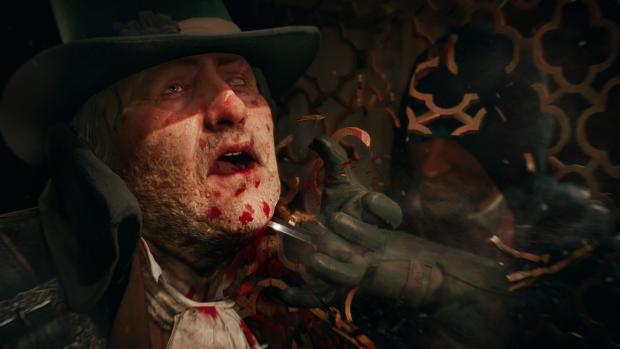
The mission I just described was great fun, I can’t deny that. The location, the mission design, all fantastic. The impression I got, however, is that not all missions are created equal – almost all of the other missions I got involved with were, well, a bit of a grind after visiting Notre Dame. Go to X location, follow someone, gather information, and don’t do much else. The variety seems to be lacking, but, what we get in the finished product could offer more than what I saw in the preview.
A number of technical gaffs have had a serious knock on my overall impression of Unity. I managed to get Arno stuck on innocuous looking objects far more than would be deemed acceptable in a finished title (and this was apparently “near complete” code). Arno would become an immovable object climbing over statues, stuck between walls, or refuse to come out of the haystack in which he was hiding. The only way out of this was to fast travel to another location, sometimes voiding a mission half way through. Couple this with a slew of broken animations, a fluctuating frame-rate and some flat out dull mission design (especially in side quests), and, well, consider me concerned. Unity could be a beautiful yet dull game punctuated by some inspired moments, or the final game could offer a more consistent experience. I guess we’ll see soon enough.
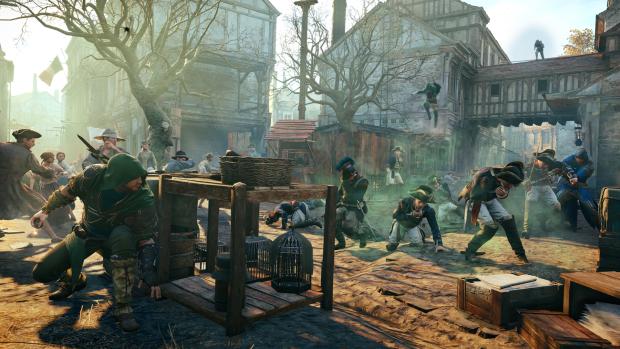
Unity’s biggest addition in terms of gameplay is the addition of online play, something that is completely new to the series. Two and four player co-op missions are available, and these are accessed directly from the single player world. Online assassin missions are placed sporadically around Paris, and to get involved in a mission you simply need to walk up to the character that represents the mission and get chatting to them. You have the choice of teaming up with strangers or inviting friends to your little slice of Paris, and it’s a good system. I get the feeling the unobtrusive way the developers have handled the addition of online play to a franchise that has been a solo experience up to now will be welcome to Creed fans. If you want to go online, you can, if you don’t? You don’t have to.
The co-op mission themselves differ both in terms of your progression through the single player campaign, and on the type of mission you opt to join. Two player co-op missions are much more story driven, and feel a lot closer to the core Assassins Creed experience – there are cut scenes, you get a target, you sneak around a bit and come up with a strategy to take the target down. The four player co-op missions are much closer to what I was expecting from Unity – more sandbox oriented, sort of a playground in which to play out your little fantasy. The missions are competitive, ‘Be the first to find X painting’, ‘Be the first to kill X number of guards’, that sort of thing. It’s fun, if a little loose. On initial impression, the two player co-op missions could be a real hit with the true AC crowd, while the four player missions could split opinions – a welcome change of pace perhaps, but they do venture quite far from the tried and tested formula. It’s worth noting that I experienced no lag while travelling around in co-op Paris, if this translates to the finished product, it will represent quite the technical feat.
Paris is a delight not only for the eyes but also for the ears, as a bank of voices, sounds and general chit chat flood every inch of the French capital. The latest weapon in the assassins arsenal is the Phantom Blade, a wrist mounted weapon that acts much like a crossbow. It fires silently (at least as far as the enemy is concerned), but unleashes a lovely thwack-twang every time it is used. The illusion of walking and stalking the Parisian streets is brought crashing down every time anyone with any meaning in the game speaks. Background characters all speak with broad French accents. Everyone else? English. Some speak the queen’s English, others speak with a thick Bristolian twang that is just unbearable. ‘This your first time in Les Miracal?’ ‘Oui’. All spoken like a true Wiltshire farmer. Given that Arno himself speaks with a proper French accent, this is a little odd.
It remains to be seen how the finished package comes together. This preview has left me worried for Assassins Creed Unity. The ambitious vision of Paris may not be enough to disguise stagnation in gameplay, and relying on the addition of online elements seems like a risky move to me. That said, my time with Unity saw some real high points, and I hope that many more of these make the cut come launch day.
Article based on an Ubisoft hosted preview event.


